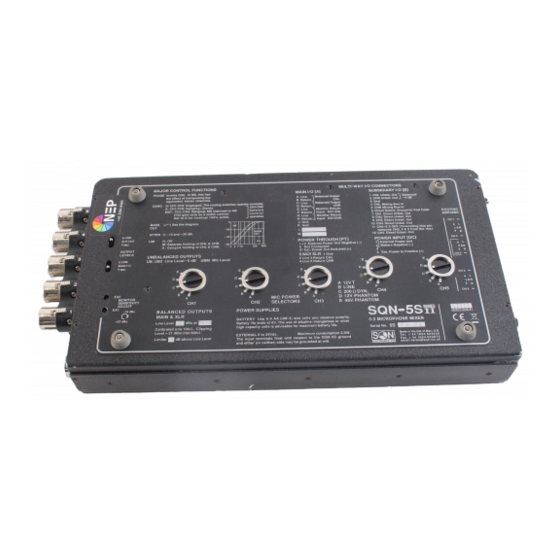
Table of Contents
Advertisement
Quick Links
SQN-5S User's Handbook
1 INTRODUCTION
1. INTRODUCTION The basic information necessary to allow a recording engineer to operate the SQN-
5S audio mixer is permanently displayed on its baseplate and cannot be lost. The aim of these instructions
is to explain the mixer's facilities and functions in more detail to those who are already familiar with the
Microphones and techniques that are employed by professional sound recordists.
Users of the earlier SQN mixers may be interested know how the new SERIES II version of the SQN-5S
relates to the previous model. The new mixer retains as far as possible the format of the old. It has five
input channels and two main output channels. Access has been provided to the Post-Fader outputs of all
of the channels so that it is possible to feed five fader-controlled (unbalanced) outputs to an external
recorder. Pre-fade listening to four of the input channels is included, as is a 'slating' microphone. The
power wiring allows the fuse-protected feeding of external power to other equipment, controlled by the
mixer's Power Selector switch. The Phones Volume control, with its tall knurled knob, is located on the
left panel. The Master Volume, with its 0dB detent, is mounted on the right panel with a similar format to
the [PAN] controls. The essential differences between this and the first generation are the addition of a
second pair of buffered line drivers and extra pair of monitoring return inputs, thus allowing the mixer to
be used with two cameras. Several more unbalanced outputs have also been added, bringing the total up
to four.
Mixing And Matrixing. The SQN-5S retains most of the control format popularized by the previous
SQN-4S SERIES IVe mixers. In addition to the normal routing of individual channels, the mixer can be
configured as a Stereo Pair, with or without MS matrixing together with one other pan-pottable and two
switch-routable channels. The modes of operation for the CH1/CH2 pair are selected by the [GANG 1-2]
switch:
1. TWIN MONO
2. STEREO
3. MID-SIDE (with matrixing to or from AB stereo)
The effects on the operation of the other controls of selecting these three modes are described in section
15 below
1. INTERNAL BATTERY. The SQN-5S should be powered by AA size alkaline cells such as
Mallory Type MN 1500 or an equivalent. The quiescent consumption of the mixer is
approximately 135mA at 12V and with dynamic microphones about 10 hours of continuous
operation can be expected from fresh cells.
Rechargeable nickel cadmium cells may be employed for maximum economy, but types fitted
with solder tags may be found mechanically unsuitable. If all cells are good they may be recharged
in series using an external charger unit, which can be connected to the 4-way connector [DC] next
to the battery compartment door. The endurance of nickel cadmium cells will be about half that of
alkaline cells.
CONTENTS
7 MICROPHONES
15 MIXING AND MATRIXING
12 OUTPUT LIMITERS
2 POWERING THE MIXER
16 WARRANTY & SERVICE
Advertisement
Table of Contents

Summary of Contents for SQN SQN-5S
- Page 1 Users of the earlier SQN mixers may be interested know how the new SERIES II version of the SQN-5S relates to the previous model. The new mixer retains as far as possible the format of the old. It has five input channels and two main output channels.
- Page 2 The mixer’s power input terminals float with respect to the SQN-5S ground, so a supply which does not share a ground with the SQN-5S may be used, e.g. a camera battery. The power supply input of the SQN-5S is protected against connection of an external voltage with reversed polarity.
- Page 3 Level (0VU) and Nominal Peak Level on the meters of both instruments and how they are to be related. The basic calibration used at SQN is to place the Nominal Line Level at PPM4, ‘TEST’ or 0VU and then to treat the Nominal Peak Level as being 8dB above this, in the case of the PPM or VU meter or 6dB above in the case of the Nordic type of meter.
- Page 4 7. MICROPHONES The five identical XLR-3F microphone input connectors are wired to conform with the IEC standard (Pin 1 ground, Pin 2 in phase and positive for T-powering). The SQN-5S is designed to accommodate all professional microphones and assumes a source impedance for dynamic microphones in the range 150-600 Ohms.
- Page 5 11. AUDIO LEVEL METERS The basic type of metering employed on the SQN-5S is the Peak Programme Meter (PPM). This was chosen as providing the maximum information about the relationship between the signal level and the overload point of the recorder.
- Page 6 12. OUTPUT LIMITERS Location recording frequently puts the recording engineer in a situation in which he or she has no control over the ambient sound level. Accordingly, the SQN-5S has been provided with a pair of output peak limiters that may be confidently employed at all times. Coming into operation just below peak level, they accommodate overloads of up to 20dB with an attack time of half a millisecond and a release time of 100ms.
- Page 7 250mm to 1.5m from the mixer, depending upon the ambient noise level. 15. MIXING & MATRIXING CONTROLS The SQN-5S SERIES IVe mixer is intended to work with various types of input signal and particularly to accommodate the use of Mid-Side microphones and Mid- Side recording.
- Page 8 PANpot. This is for the benefit of those who wish to use the channels separately to feed other equipment. 16. WARRANTY & SERVICE The SQN-5S is guaranteed for a period of 24 months from the date of purchase. This guarantee covers defects in manufacture, workmanship and materials and includes the cost of parts, labour and return carriage.

Need help?
Do you have a question about the SQN-5S and is the answer not in the manual?
Questions and answers